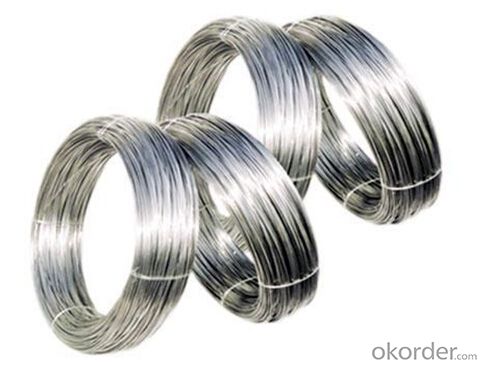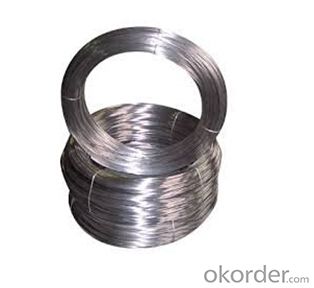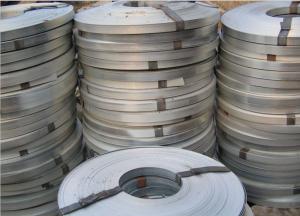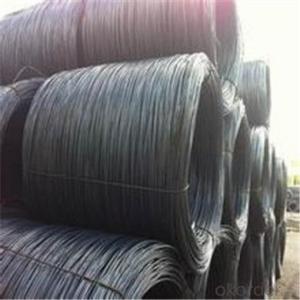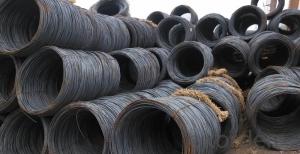Stainless Steel Wire Rod/ Dia 0.5mm Stainless Steel Wire
- Loading Port:
- Tianjin
- Payment Terms:
- TT OR LC
- Min Order Qty:
- 10 m.t.
- Supply Capability:
- 10000 m.t./month
OKorder Service Pledge
OKorder Financial Service
You Might Also Like
Specification
Stainless Steel Wire Rod/ Dia 0.5mm Stainless Steel Wire
Details of the Stainless Steel Wire Rod/ Dia 0.5mm Stainless Steel Wire
| Steel Grade | Q195-Q235,Q235,SAE 1008-1018 Hot Rolled Steel Wire Rod |
| Diameter | 5.5, 6.5, 7,8, 9,10, 12,14mm.etc. |
| Coil weight | 2m.t. |
| Application | drawing, construction materials, machinery parts,construction for Houses, Bridges, Roads,Packing |
| Deliver Time | 25-30 days after receipt of L/C or deposit by T/T |
| Packing | In coils, loading in container or by bulk vessel |
| Payment terms | 1).100% irrevocable L/C at sight. |
| 2).30% T/T prepaid and the balance against the copy of B/L. | |
| 3).30% T/T prepaid and the balance against L/C |
| Chemical Composition(%) | ||||||
| C | Mn | Si | S | P | Cr | |
| SAE1006B | 0.03~O.07 | ≤0.32 | ≤0.30 | ≤0.045 | ≤0.040 | 0.3-0.35 |
| Mechanical properties | ||||||
| Yield strength(N/mm2) | Tensile strength(N/mm2) | Elongation(%) | ||||
| 250-280 | 350-380 | ≥32 | ||||
| Grade | Chemical Composition(%) | |||||
| C | Mn | Si | S | P | Cr | |
| SAE1008B | 0.10max | 0.3~O.50 | 0.15max | 0.050max | 0.040 max | 0.3-0.35 |
| Mechanical properties | ||||||
| Yield strength(N/mm2) | Tensile strength(N/mm2) | Elongation(%) | ||||
| ≥195 | 315-430 | ≥30 | ||||
Supplier of the Stainless Steel Wire Rod/ Dia 0.5mm Stainless Steel Wire
CNBM International Corporation is the most import and export platform of CNBM group(China National Building Material Group Corporation) ,which is a state-owned enterprise, ranked in 270th of Fortune Global 500 in 2015.
With its advantages, CNBM International are mainly concentrate on Cement, Glass, Iron and Steel, Ceramics industries and devotes herself for supplying high quality series of refractories as well as technical consultancies and logistics solution.


Delivery of the Stainless Steel Wire Rod/ Dia 0.5mm Stainless Steel Wire
Packaging Detail | Sea worthy packing /as per customer's packing instruction |
Delivery Detail | 15 ~ 40 days after receiving the deposit |
Products Show

FAQ:
Are you a trading company or manufacturer? | Manufacturer |
What’s the MOQ? | 3 metric ton |
What’s your delivery time? | 15-35 days after downpayment received |
Do you Accept OEM service? | Yes |
what’s your delivery terms? | FOB/CFR/CIF |
What's the Payment Terms? | 30% as deposit,70% before shipment by T/T |
Western Union acceptable for small amount. | |
L/C acceptable for large amount. | |
Scrow ,Paybal,Alipay are also ok | |
Why choose us? | Chose happens because of quality, then price, We can give you both. Additionally, we can also offer professional products inquiry, products knowledge train (for agents), smooth goods delivery, excellent customer solution proposals. |
What's your available port of Shipment? | Main Port, China |
What’s your featured services? | Our service formula: good quality+ good price+ good service=customer's trust
|
Where are your Market? | Covering more than 160 countries in the world |
- Q: What are the major barriers to entry in the steel wire rod market?
- The major barriers to entry in the steel wire rod market can be attributed to several factors. Firstly, the high capital requirements present a significant barrier for new entrants. Establishing a steel wire rod production facility requires substantial investment in machinery, equipment, and infrastructure. Additionally, the costs associated with raw materials, such as iron ore and scrap metal, further add to the financial burden. This high capital requirement limits the entry of new players, as they may struggle to secure the necessary funds to compete with established industry participants. Secondly, economies of scale play a crucial role in the steel wire rod market. Existing manufacturers often benefit from a larger production base, enabling them to achieve cost efficiencies through bulk purchasing, streamlined production processes, and distribution networks. This advantage makes it difficult for new entrants to compete on a cost basis, as they would need to achieve similar economies of scale to remain competitive. Furthermore, the steel wire rod market is highly competitive, with a few dominant players holding significant market share. These established companies have strong brand recognition, longstanding customer relationships, and established distribution channels. This makes it challenging for new entrants to gain market share and attract customers away from these well-established players. Regulatory barriers also pose challenges for new entrants. The steel industry is subject to various government regulations and compliance requirements, including environmental regulations and safety standards. These regulations can be complex and costly to navigate, adding further barriers to entry for potential new players. Lastly, technological advancements and innovation are essential in staying competitive in the steel wire rod market. Existing manufacturers often have access to advanced technology and research and development capabilities, allowing them to produce higher quality products and drive efficiency improvements. New entrants may struggle to match these technological capabilities, making it difficult to gain a competitive edge. In summary, the major barriers to entry in the steel wire rod market include high capital requirements, economies of scale, strong competition from established players, regulatory compliance, and technological advancements. These barriers make it challenging for new entrants to penetrate the market and establish a foothold.
- Q: How is steel wire rod used in the production of wire for automotive seat springs?
- The production of wire for automotive seat springs relies heavily on steel wire rod, which is an indispensable component. To enhance its mechanical properties, such as strength, durability, and flexibility, the wire rod undergoes a series of steps involving heating and cooling. Once the steel wire rod has been processed, it is drawn down further to achieve the desired diameter for the seat springs. This drawing process entails pulling the wire rod through a set of dies, simultaneously reducing its diameter and increasing its length. This step is critical to attaining the desired mechanical properties and ensuring that the wire can withstand the stress and pressure experienced by automotive seat springs. Once the wire has reached the desired diameter, it is then shaped into the specific coil form required for the seat springs. Through the use of specialized machinery, the wire is coiled and molded into the desired shape, ensuring that it meets the design requirements and provides the necessary support and comfort for automotive seats. The use of steel wire rod in wire production for automotive seat springs is crucial due to its exceptional tensile strength and resistance to fatigue and corrosion. These properties enable the wire to withstand the constant pressure and movement experienced by automotive seat springs, resulting in long-lasting performance and durability. Additionally, steel wire rod offers the advantages of being cost-effective and readily available, making it the preferred choice for automotive manufacturers. Its versatility allows for customization, enabling the production of wire with specific characteristics tailored to meet the requirements of different types of seat springs. In conclusion, steel wire rod plays a vital role in the production of wire for automotive seat springs. Through various processing steps, the wire rod is transformed into high-quality wire that possesses the necessary strength, durability, and flexibility to support and provide comfort to automotive seats.
- Q: What are the main factors affecting the market segmentation of steel wire rod?
- The main factors affecting the market segmentation of steel wire rod include the type of applications that the rod is used for, such as construction, automotive, or manufacturing industries. Other factors include the quality and specifications of the steel wire rod, price, geographical location, and the preferences and requirements of customers in different market segments. Additionally, factors like technological advancements, government regulations, and competition within the industry can also impact the market segmentation of steel wire rod.
- Q: What are the different microscopy techniques used for steel wire rod analysis?
- There are several microscopy techniques used for steel wire rod analysis, including optical microscopy, scanning electron microscopy (SEM), transmission electron microscopy (TEM), and atomic force microscopy (AFM). These techniques allow for the examination of the microstructure, surface morphology, elemental composition, and defects in steel wire rods, providing valuable information for quality control and material characterization purposes.
- Q: What are the main trends in the steel wire rod industry?
- Some of the main trends in the steel wire rod industry include increasing demand for steel wire rods in various sectors such as construction, automotive, and manufacturing due to their strength and versatility. Additionally, there is a growing emphasis on sustainability and eco-friendly practices, leading to the development of more environmentally-friendly steel wire rods. Furthermore, technological advancements and automation are playing a significant role in improving efficiency and productivity in the industry. Lastly, globalization and international trade are influencing the market dynamics, with emerging economies becoming key players in the production and consumption of steel wire rods.
- Q: How is steel wire rod used in the manufacturing of wire rope clamps?
- Steel wire rod is used in the manufacturing of wire rope clamps as it serves as the raw material for creating the clamps' sturdy and durable structure. The steel wire rod is typically formed, shaped, and manipulated into the desired clamp design, providing the necessary strength and reliability to secure the wire rope in place.
- Q: How is steel wire rod tested for flexural strength?
- Steel wire rod is tested for flexural strength using a three-point bending test. In this test, the rod is placed horizontally on two supports, and a load is applied at the center of the rod. The amount of load required to cause the rod to bend or fracture is measured, providing a measure of its flexural strength.
- Q: What are the different types of steel wire rod surface cleaning methods for wire galvanizing flux?
- There are several types of steel wire rod surface cleaning methods used for wire galvanizing flux. These include mechanical cleaning methods such as abrasive blasting or shot blasting, chemical cleaning methods like pickling or acid cleaning, and electrolytic cleaning methods. Each method has its own advantages and suitability depending on the specific requirements and condition of the steel wire rod.
- Q: What are the different types of steel wire rod finishes for improved chemical resistance?
- There are several types of steel wire rod finishes that can improve chemical resistance. These include galvanized finishes, which involve coating the wire rod with a layer of zinc to protect it from corrosion caused by chemicals. Another option is stainless steel finishes, where the wire rod is made from a stainless steel alloy that is highly resistant to chemical corrosion. Additionally, there are epoxy-coated finishes, where a layer of epoxy resin is applied to the wire rod to provide an extra barrier against chemical contact.
- Q: What is the typical chemical composition of steel wire rod?
- Steel wire rod can have different chemical compositions depending on its grade and intended use. The main element in steel wire rod is iron, accompanied by small quantities of carbon, manganese, phosphorus, sulfur, and silicon. Carbon plays a significant role in providing strength and hardness to the material. Manganese is commonly added to enhance the steel's hardenability and strength. Phosphorus and sulfur, which are impurities, are typically minimized to avoid negative impacts on the steel's properties. Silicon is incorporated to improve deoxidation and corrosion resistance. It should be noted that the amounts of these elements can vary in different grades of steel wire rod. Additionally, other alloying elements like chromium, nickel, or molybdenum may be included to achieve specific properties required for different applications.
Send your message to us
Stainless Steel Wire Rod/ Dia 0.5mm Stainless Steel Wire
- Loading Port:
- Tianjin
- Payment Terms:
- TT OR LC
- Min Order Qty:
- 10 m.t.
- Supply Capability:
- 10000 m.t./month
OKorder Service Pledge
OKorder Financial Service
Similar products
Hot products
Hot Searches
Related keywords






